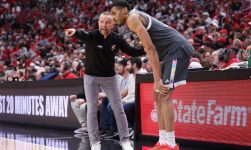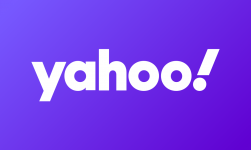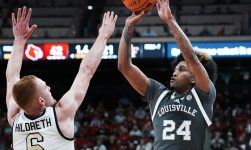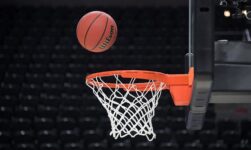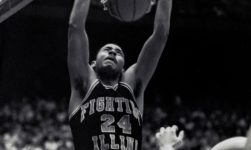Arguing that NLRB regional director Laura Sacks’ decision to recognize Dartmouth College men’s basketball players as employees within the meaning of the National Labor Relations Act “will affect and have a far-reaching impact” on all “current and future” college athletes and “the NCAA membership as a whole,” the NCAA Thursday asked the NLRB for permission to file an amicus brief in support of Dartmouth.
The NLRB is currently weighing whether to hear Dartmouth’s appeal (technically called a request to review). As Sportico detailed, the NLRB hearing an appeal—let alone siding with Dartmouth—is anything but automatic. The board, which currently consists of four members (three of whom were nominated by Democratic presidents), only takes on an appeal when there are the “compelling reasons” and when either the regional director decided a substantial factual issue that is “clearly erroneous” and such a mistake “prejudicially affects” rights or a “substantial question of law or policy is raised” because the regional director’s decision departs from NLRB precedent.
More from Sportico.com
Dartmouth players, who have been employees of Dartmouth since February, unionized in March and are represented by the SEIU Local 560. Dartmouth has refused to bargain with the union, which has a right to negotiate players’ wages, hours, insurance, health care, disciplinary procedures, support services and other mandatory subjects of employment.
If the NLRB accepts the NCAA’s 32-page amicus brief, the agency’s board will see that, like Dartmouth, the NCAA portrays the “unprecedented” nature of college athletes as employees in a problematic light.
Although U.S. colleges have a long history of employing students—some of whom form unions that bargain with their college (for example, dining services student employees at Dartmouth have unionized and Dartmouth bargains with that union)—the NCAA stresses the NLRB, federal courts, the U.S. Supreme Court and Congress “have never declared student-athletes to be employees” under the NLRA.
The NCAA further asserts the recognition of a single team as a bargaining unit would destabilize labor relations. The association stresses that NLRB cases involving pro sports have involved “league-wide bargaining units” rather than one team.
This type of argument has resonated with the NLRB in the past. A decade ago, the NLRB reasoned that because Northwestern University is the only private college in the Big Ten, and because the NLRA only governs private colleges whereas athlete employment at public colleges is governed by varying state labor laws, it would undermine labor relations to recognize Northwestern football players as employees while players at Michigan, Ohio State and other Big Ten schools remain non-employees and would be outside the NLRB’s jurisdiction.
The NCAA concedes the Dartmouth situation is structurally different from the one in Northwestern since the Ivy League consists of eight schools, all of which are private. Yet the NCAA argues the NLRB should view Dartmouth in the broader context of Division I sports, which includes numerous public universities. The NCAA notes that Dartmouth basketball played five public universities last season and that of the 68 schools that competed in men’s March Madness, 48 were public.
The NCAA also outlines what might be described as a parade of horribles should Dartmouth basketball players remain employees. That status, the NCAA contends, would “marginalize the importance of educational programs” and “isolate, rather than integrate student-athletes as fundamental parts of the whole—the student body.”
Expect pushback from the SEIU on these types of assertions.
As noted above, Dartmouth employs and bargains with unionized student workers and there is no indication that arrangement has marginalized their studies or segregated them from classmates. In fact, one dining services employee, Cade Haskins, has been able to juggle his dining services employment, studies and role as a forward on the basketball team. Also, in concluding the players are employees, Sacks notably stressed that Dartmouth (like other D-I programs) substantially controls players and places them in a position where athletics are prioritized.
The NCAA finds itself in a tricky spot arguing that employment would harm college sports given that the NCAA hopes to settle three antitrust cases (House v. NCAA, Carter v. NCAA and Hubbard v. NCAA) in part by adopting a pay-for-play model. The settlement, which is not yet finalized and requires approval by U.S. District Judge Claudia Wilken, contemplates colleges, like teams in a pro league, being able to pay athletes in a salary cap and revenue-sharing framework.
The NCAA tries to tackle the presence of the settlement by insisting college athletes entering into NIL arrangements with schools “has no bearing on this matter, even if Dartmouth men’s basketball players receive NIL pay directly from Dartmouth at some point in the future.” A likely counter argument is that a school labeling direct pay as “NIL,” as opposed to compensation for labor, could prove more form over substance. NIL is supposed to ensure college athletes can use their right of publicity to sign endorsement and influencing deals. However, particularly with many NIL collectives closely linked to schools, NIL has evolved (or devolved) into a pay scheme to recruit and retain athletes at school—as if NIL was tantamount to a signing or retention bonus offered by an employer.
The NCAA also suggests that if the NLRB finds college athletes are employees, the agency will have acted outside of authority granted by Congress. Citing the U.S. Supreme Court’s ruling in West Virginia v. Environmental Protection Agency (2022), where the Court limited the authority of the EPA to regulate greenhouse gas emissions on grounds Congress didn’t delegate such authority, the NCAA contends major policy decisions like whether college athletes are employees ought to be decided by Congress rather than agencies unless the agencies can identify clear congressional authority. A rebuttal is that the NLRB has long determined whether workers count as employees and, in fact, the agency’s clear expertise, as authorized by federal law, is on that issue.
The reference to West Virginia v. EPA could foreshadow a potential legal debate should courts eventually decide whether college athletes are employees: Does the NLRB have the authority to determine they are employees?
Expect many more developments on this topic in the coming months.
Best of Sportico.com

